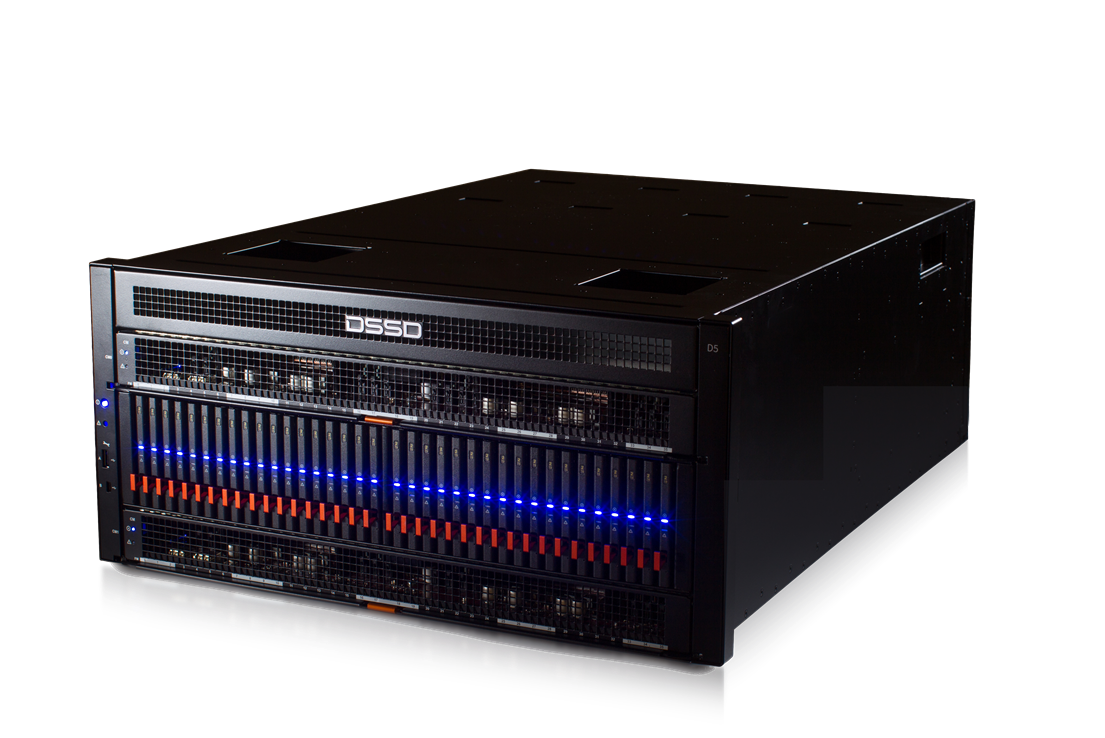
Just when you thought EMC was done with alphabet soup acronyms and on to starting everything with a V or X along comes the DSSD D5. DSSD is a company acquired by EMC back in 2014 and their “D5” is an all flash storage array geared toward super IO intensive workloads. It’s new system that’s been in development for awhile so you may not see a lot of features you would find on other all flash arrays. Instead it’s been built from the ground up as a “go fast machine” that connects to Linux hosts via PCIe Gen 3.
Recently I was able to attend an EMC/DSSD presentation on the D5. Here are my notes from that event. Any numbers, details, etc. may change from the time of this post (or I may have mistaken something), so please consult with your EMC rep or valued partner for more details. EMC and partners can find more details on EMC’s site, https://www.emc.com/auth/rpage/ec-for-dssd.htm
DSSD D5
- 5U rack scale flash platform
- Physically very deep, and very heavy (140lbs)
- 36 flash modules
- Flash module with ASIC and proprietary software
- Can be purchased with half pop (18 count)
- 2TB/4TB FMs (larger ones on the way)
- Redundant controllers (Called an IOM or service module)
- No serial, connect via SUB
- Each IOM has an Ethernet port for mgmt
- Redundant power supplies (x4)
- Redundant fans (x5)
- 48 PCIe Gen3 x4 Client Ports per IOM (controller)
- Total of 96 PCIe Gen 3 ports
- Redundant Control Modules (CM)
- Full of DRAM
- Uses NVMe storage protocol
Max Performance on *single* DSSD D5 unit
- 4k Random Reads, 8M to 10.6M IOPS
- 32k Random Reads, 101.4 GB/s
- 32k Sequential Writes, 21.6 GB/s
DSSD Flash Module (FM)
- 18 or 36 FMs per D5
- 2TB or 4TB
- Built in DRAM????
- Future FMs will offer grater capacities and support 3D NAND and NGNVM
- Industry’s first hot-swappable and dual connected PCIe Gen3 x4 based FM
- Power delivery to flash bursts up to 60 Watts
- Hot swappable
DSSD PCIe Card
- Cable lengths, 1m, 2m, 3m or 4m copper
- Plans for optical cables
- Supports up to two cards per host
- Can support more, but right now is limited without qualification
- Always on multipathing
“Flood”
- Flood is the client software, CLI, BUI
- Same name for all the software that runs on the D5, client cards, etc
- Direct memory API
- Allows data access with less system integration layers to improve formance
- Maps users space directly to flash
- Object store supporting key-value, directory, block and file object types
- Data protector, Data manager, Application manager, appliance CLI
- DSSD uses object store
- Presented as volumes as block stores to the clients
- Can use API to directly access objects
- Volumes can contain all object types and support FLENs
- Fragment length is configured per object, from 64B to 32KB
- Object types:
- Volume
- Presented from the D5 to the client, clients create objects in
- Directory
- Key-Value
- Block
- Objects are containers of fragments
- IO must be FLEN aligned
- Higher performance than file objects
- Uses API or block driver (API is faster)
- File
- Allow non-aligned IO
- POSTIX Compliance
- DSSD application specific plug-ins available
- Volume
Data Resiliency
- CRC for data in flight
- Always-on multipathing
- Totally automatic, nothing to configure
- PCIe multicast write
- Redundant hardware FRUs
- Flash physics control
- Extends life of SSD via magic
- Space-time garbage collection
- Improves upon generic GC, reduced write amplification
- Segregates data y observed lifetime
- British traveler in a blue DSSD saves your drives from wear
- Always-on Cubic RAID
- 2x greater reliability over other RAID types, same overhead (17%)
